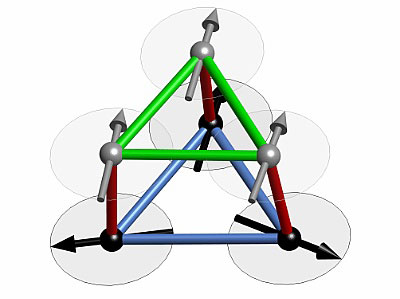| Posted: Jul 26, 2016 |
Observation of a quantum spin liquid
(Nanowerk News) A novel and rare state of matter known as a quantum spin liquid has been empirically demonstrated in a single crystal of the compound calcium-chromium oxide by a team of Helmholtz scientists in Berlin and Dresden.
|
|
What is remarkable about this discovery is that according to conventional understanding, a quantum spin liquid should not be possible in this material. A theoretical explanation for these observations has now also been developed.
|
|
This work deepens our knowledge of condensed matter and might also be important for future developments in quantum information. The results have just been published in Nature Physics ("Physical realization of a quantum spin liquid based on a complex frustration mechanism").
|
 |
| A section from the crystal lattice of calcium-chromium oxide showing how the spins are subject to competing interactions. In this ball-and-stick model, the green and red sticks connecting the atoms (grey and black balls) represent ferromagnetic interactions while the blue sticks represent anti-ferromagnetic interactions. (Image: HZB)
|
|
Based on our everyday experience, we expect matter at low temperatures to freeze solid with the atoms fixed in a regular arrangement. The magnetic moments arising from the atomic electron spins in magnetic materials also come to rest and become rigidly oriented as temperature falls. However, there are some rare exceptions. In what is referred to as a quantum spin liquid, the orientations of the electronic spins remain mobile even at temperatures near absolute zero.
|
|
According to conventional understanding, this phenomenon can occur if the spins are arranged in triangular geometries and if the interactions between them are antiferromagnetic favoring antiparallel alignment of the spins.
|
|
For three atoms forming the corners of a triangle, the electronic spins of these atoms cannot simultaneously be oriented antiparallel with respect to the others. This “frustration” can prevent the spins from coming to rest in a particular orientation even at zero temperature – instead they move like atoms in a liquid.
|
|
However, in many materials frustration is surpassed by magnetic order at very low temperatures, caused by even minute interactions. For these reasons, only a few isotropic materials have been proposed as spin-liquid candidates.
|
|
Monocrystals with complex magnetic interactions
|
|
Now an international team of physicists, headed by Prof. Bella Lake from the Helmholtz center in Berlin – and with further colleagues from the Helmholtz centers in Berlin (HZB) and Dresden (HZDR) – has produced and investigated the first single crystals of calcium-chromium oxide (Ca10Cr7O28).
|
|
The atoms in calcium-chromium oxide are arranged in what is known as Kagomé lattice – reminiscent of the pattern of triangles and hexagons woven in Japanese basketry. As a result, a complex set of isotropic magnetic interactions develop in this material, consisting of not only antiferromagnetic interactions but also much stronger ferromagnetic interactions that according to conventional understanding should prevent the existence of spin-liquid behavior.
|
|
Magnetic and neutron-scattering experiments conducted in Germany, France, England, and the USA, as well as muon spectroscopy experiments performed in Switzerland have, however, shown that the spins in these samples retain their collective motion even at temperatures as low as 20 millikelvin and behave like a quantum spin liquid.
|
|
More candidates für spin liquids expected
|
|
“We have proved empirically that interesting quantum states like spin liquids can also occur in considerably more complex crystals with different magnetic interactions”, says Dr. Christian Balz, lead author of the work.
|
|
Prof. Johannes Reuther, theoretical physicist at HZB, has now been able to extend the theoretical model of spin liquids with the help of these experimental clues. He has used numerical simulations to show how the different magnetic interactions in calcium-chromium oxide compete with one another and keep the spins dynamic.
|
|
Prof. Bella Lake also explains: “The work expands our understanding of magnetic materials, and also shows us that there are potentially far more candidates for spin liquids than expected. This could be important for the advancement of quantum computers in the future because spin liquids are one of the possible building blocks for carrying the smallest unit of quantum information, known as a qubit.”
|
|
Dr. Thomas Herrmannsdörfer, physicist at the Dresden High Magnetic Field Laboratory of the HZDR further comments: "Large-scale infrastructures of the Helmholtz society are essential in order to ascertain the scientific and technological potential of complex materials. These facilities provide access to scattering experiments as well as extreme sample conditions such as highest magnetic fields and lowest temperatures, not available otherwise.”
|

